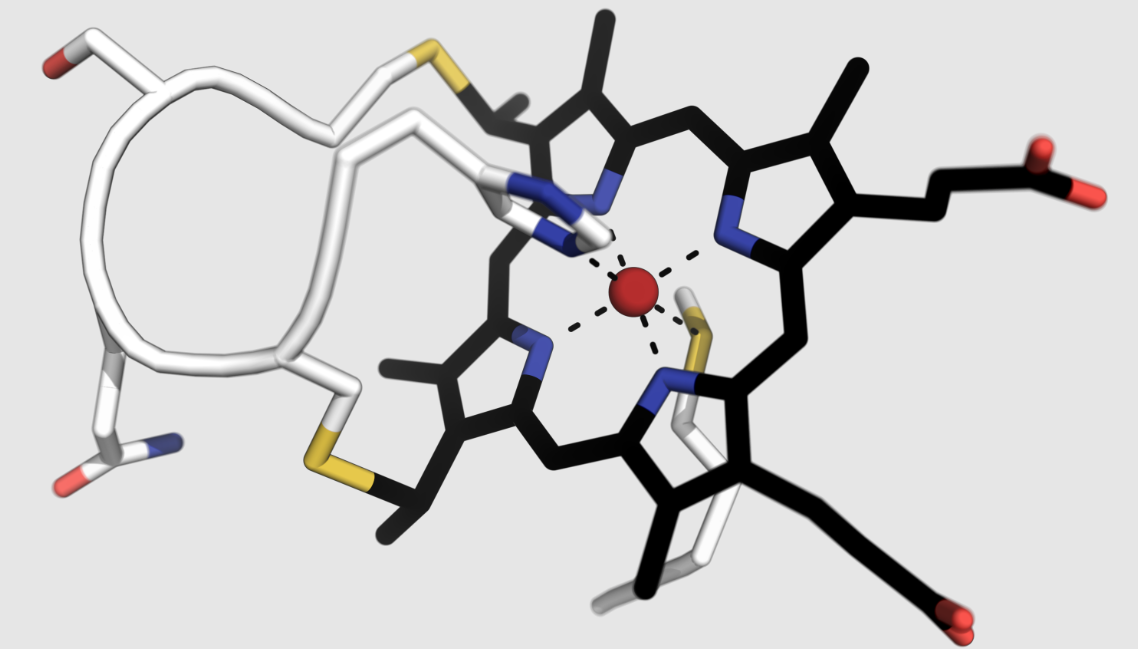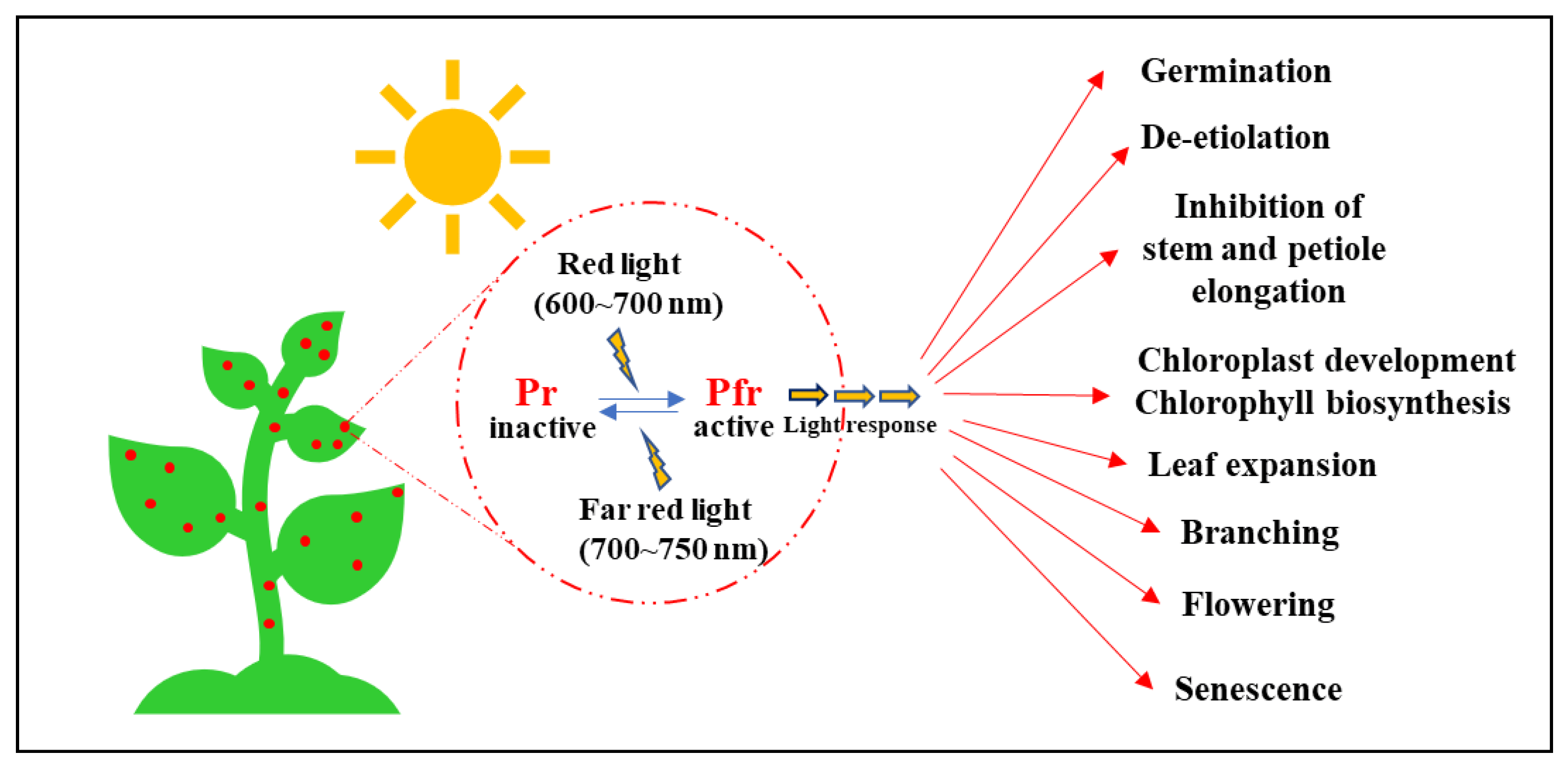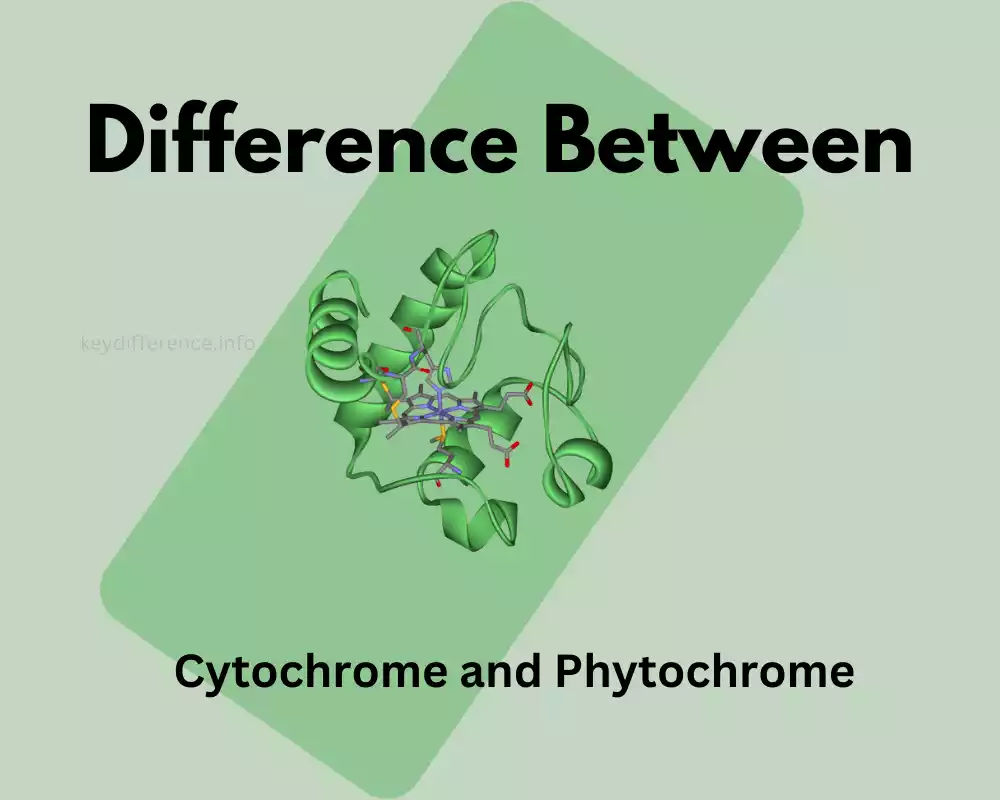Cytochrome and Phytochrome: The main distinction between cytochrome and phytochrome lies in their respective functions; cytochrome is an electron transfer hemeprotein involved in aerobic respiration while phytochrome acts as a photoreceptor and has high sensitivity towards far-red and red wavelengths of visible spectrum light.
Living organisms produce different pigments to meet their various needs. Some pigments absorb light while others act as respiratory pigments. Cytochrome, for instance, serves as an electron transporter during aerobic respiration while phytochrome acts as an optical receptor, absorbing far-red and red radiation from visible spectrum radiation – both are vital parts of plant development processes.
Cytochrome and Phytochrome provide a brief introduction.
Introduction Both phytochrome and cytochrome play an integral part in biological processes, playing crucial roles in energy transfer as well as signaling processes. Both compounds possess unique functions and specific properties which make them stand out among their counterparts. Below we offer a brief description of each to better comprehend their significance for various situations.
Cytochrome:
Cytochromes are proteins found in many species of organisms such as plants, bacteria, and animals that play an essential role in cell metabolism and electron transport chain processes. Cytochromes feature heme groups which have the unique capability of binding electrons while moving them – this makes cytochromes indispensable components in energy metabolism processes within cells.
Phytochrome:
Phytochromes are special photoreceptor proteins found primarily in plants that detect and respond to light stimuli such as far-red and red wavelengths of light, including seed germination, photoperiodism, and shading processes. They play an essential part in controlling plant growth and development as well as other light-dependent processes like photoperiodism.
Understanding their various functions is essential to comprehending cell biology, energy metabolism, and plant physiology. In the following sections, we will delve deeper into the functions, structures, and differences between phytochrome and cytochrome proteins to gain a better understanding of their distinct features and roles in various biological systems.
Importance of these molecules in biological processes
- Cytochrome Importance for Cellular Respiration: Cytochromes play an integral part in cell respiratory processes by acting as electron transport chain proteins that transport electrons within cells to generate Adenosine Triphosphate (ATP), the currency for energy in living systems.
- Cytochromes play an integral part in oxidative phosphorylation: The process that allows cells to generate ATP by coupling electron transport with ATP production – thus optimizing the use of nutrients as energy sources.
- Redox Reactions: Cytochromes play an integral part in numerous redox reactions within cells by acting as electron carriers to facilitate electron exchange across molecules and regulate metabolism pathways and enzymes. Redox activity is essential to proper metabolic pathways as well as enzyme processes functioning correctly.
Phytochrome Importance for Plant Growth and Development:
- Phytochromes play a crucial role in controlling plant development: By responding to signals from the sun, such as stem elongation, seed germination, and leaf expansion as well as flowering and fruit ripening.
- Photomorphogenesis: Phytochromes have an immense effect on plant morphology when exposed to different lighting conditions, as they regulate the expression of certain genes involved in photomorphogenesis, leading to dramatic shifts in appearance, production of pigments, and overall development patterns of plants.
- Photoperiodism: Plants use phytochromes to detect variations in day length, which allows them to alter their growth rate and adapt accordingly, adapting to seasonal shifts like flowering or dormancy. This process plays a pivotal role in adapting to seasonal shifts like flowering or dormancy.
- These molecules play an essential role: In numerous biological processes. Cytochromes play an essential role in electron transport and energy metabolism while phytochromes serve as regulators of plant development, growth, and other light-dependent processes. Understanding their significance will deepen our knowledge of cell biology, energy production, and plant physiology – plus their importance may help identify new therapeutic targets.
Cytochrome

- Cytochromes are proteins that play an essential role in many biological processes, particularly regarding cell respiration and electron transport chain activity. Their primary component is an iron-ion complex enclosed within a porphyrin ring structure that enables electron transfer reactions.
- Cytochromes serve a vital purpose during cellular respiration: helping transfer electrons during respiration processes to generate energy via conversion to ATP (adenosine triphosphate). They play an essential part of electron transportation chains located both on mitochondrial membranes in eukaryotic cells as well as prokaryotic plasma membranes, where electron transportation takes place.
- As part of cellular respiration, cytochromes accept and give electrons, passing them from one complex of proteins to the next in an electron transport chain. This creates an electrochemical gradient across the membrane that drives the production of ATP through Oxative Phosphorylation; by helping with electron transfers cytochromes also play an essential part in producing its energy currency ATP.
- Cytochromes play an integral part in various redox reactions in cells. Acting as electron carriers, cytochromes transport electrons between enzymes and molecules involved in metabolic pathways. Redox reactions play an integral role in supporting essential biochemical processes like the metabolism of drugs or toxins as well as the biosynthesis of essential molecules or detoxification of harmful substances.
- There are various kinds of cytochromes, designated by letters like cytochrome a or b and so forth. Each has specific roles and functions in electron transportation chains – for instance, cytochrome is essential in moving electrons between complexes I and IV within mitochondrial electron transport chains.
- Cytochromes are essential elements of cell respiration, electron transportation, and redox reactions – they aid the generation of ATP while aiding redox reactions as well. Their presence and activity are paramount for optimal cell function and involve various biological processes integral to maintaining life within each cell.
Phytochrome

- Photoreceptor proteins phytochromes can be found both within plants as well as organisms like fungi and bacteria. Their primary function is detecting light signals and responding accordingly, especially far-red and red regions of the electromagnetic spectrum. Phytochromes help coordinate various light-dependent processes within an organism’s development such as growth control or physiological responses.
- The structure of phytochromes comprises phytochromobilin, which is covalently bound with protein molecules. When exposed to light, its absorption causes it to undergo reversible chemical changes, leading the phytochrome to switch between various functional states and activate signals that alter gene expression and influence plant responses to light.
- One of the primary purposes of phytochromes lies in their participation in photomorphogenesis – or the development of plants through light. Pheochromes play an essential role in this process by controlling processes like seed germination, stem elongation, and leaf expansion, flowering as well as dormancy or dormancy of seeds through light ratios; red-to-far-red light ratios determine whether seeds remain dormant or germinate with active phytochromes encouraging this germination process.
- Photoperiodism, or plant physiological responses to changes in daylight length, requires phytochromes. They help plants detect these fluctuations so they can adjust their rate of growth accordingly; for example, flowering processes in many species of plants are controlled by phytochrome-mediated photoperiodic responses.
- Outside their essential roles in development and growth, phytochromes also play a vital role in light-dependent processes. They play an integral part in shade avoidance responses where plants recognize nearby vegetation that threatens sunlight resources by elongating stems or changing their physiology to be competitive for sunlight resources. Phytochromes play an integral part in circadian rhythm regulation, photosynthesis regulation, chloroplast development regulation, as well as specific pigment synthesis processes.
- Phytochromes have different isoforms that each possess specific characteristics and functions, including specific absorption spectra that allow plants to respond to different lighting conditions. Phytochromes can transform from active (Pr) form into their inactive counterpart (Pfr), depending on the quality of light; this allows them to act as molecular switches translating light signals into biological reactions within plants.
- Phytochromes are proteins found in plants that detect light and regulate various light-dependent processes, from photosynthesis to responding to environmental signals. By sensing and transducing photochemical signals from light sources, phytochromes play an integral part of plant physiology as they assist plants to thrive in constantly shifting light environments.
Differences between Cytochrome and Phytochrome
Cytochrome and phytochrome are integral parts of biological processes, their functions, cell locations, properties of spectral emission, molecular structure and evolutionary significance differ significantly. We will consider their differences below:
Function and Biological Role:
- Cytochrome: Cytochromes play an essential part in cell respiration by helping facilitate electron transport chains that facilitate electron transfer and produce ATP, providing energy storage capacity within cells for metabolic reactions as well as redox reactions. They play a major part in metabolic pathways as well as energy regulation processes within them.
- Photoreceptors: Phytochromes are proteins that regulate plant growth development as well as physiological response to light. They play a key role in processes like photomorphogenesis and photoperiodism as well as shading, shading control, and circadian rhythms of plants.
Cell Location and Distribution:
- Cytochromes: Cytochromes can be found in many organisms, from bacteria and plants to animals. Eukaryotic cells usually find them located within their mitochondrial inner membrane while prokaryotes contain them inside their plasma membrane.
- Phytochromes: Phytochromes can be found both within plants as well as fungi and bacteria. Their location within plant tissues such as stems, leaves, and reproductive organs varies between species.
Spectral Properties and Light Absorption:
- Cytochromes: Cytochromes do not possess specific light-absorbing properties and thus do not directly absorb light to fulfill their biological roles.
- Phytochromes: Phytochromes have the unique ability to detect changes in far-red and red light spectrums, absorbing light from approximately 666 Nm wavelength and changing conformations at this wavelength to control signaling pathways as well as controlling plant responses to light.
Molecular Structure and Composition:
- Cytochromes: Cytochromes are proteins characterized by the presence of an iron ion enclosed within a porphyrin ring and, thanks to the presence of their heme group, can participate in electron transfer reactions.
- Phytochromes: Phytochromes are composed of proteins connected via covalent bonds to an organic chromophore called phytochromobilin. When exposed to light absorption, photochemistry changes within this complex of chromophores can alter their functions causing shifts in function for phytochromes.
Evolvional Significance and Presence in Different Organisms:
- Cytochromes: Cytochromes can be found in various organisms, from bacteria and plants to animals. Their evolutionary importance has ensured they have been preserved through many branches of the Tree of Life.
- Phytochromes: Phytochromes are found not only in plants but also in other organisms like fungi and bacteria. Their purpose is to assist plants with perceiving light, helping them adapt accordingly.
Understanding the differences between phytochrome and cytochrome is essential to comprehend their specific functions in plant cells and biology. While cytochromes play a pivotal role in electron transfer and energy metabolism, phytochromes control the plant’s response to light; playing an integral part in its development and growth.
Similarities between Cytochrome and Phytochrome
Though phytochrome and cytochrome each possess individual characteristics and functions, there are some shared similarities between the two molecules. Notable ones include:
A. Role in Biological Processes:
- Cytochrome and phytochrome play an integral part in biological processes.
- Cytochromes play an essential role in cell metabolism of energy, respiration, and redox reactions across a variety of species of living things.
- Phytochromes play an indispensable role in the growth and development of plants as well as processes dependent on light such as photomorphogenesis or photoperiodism.
B. Energy Transfer and Signaling Pathways:
- Cytochrome and phytochrome proteins both play an essential role in energy transfer and signaling pathways.
- Cytochromes play an essential role in electron transport chain reactions, helping the transfer of electrons as well as producing ATP.
- Phytochromes detect light signals and initiate signaling cascades to control gene expression and physiological reactions in plants.
C. Isoforms with Specific Functions
- Both phytochrome and cytochrome exist in various forms or variations.
- Different cytochromes play key roles in cell processes that involve electron transport chain reactions.
- Phytochromes contain numerous isoforms that allow plants to detect and respond to different lighting conditions.
D. Complex Molecular Structures:
- Their Nature and Application.
- Both cytochrome and phytochrome possess complex molecular structures.
- Cytochromes contain heme groups linked to proteins’ structures that allow them to participate in electron transfer reactions.
- Phytochromes are proteins bound to chromophores via covalent bonds, which allows them to undergo changes in photochemistry and transmit light signals.
E. Biological Significance:
- Both phytochrome and cytochrome play an integral part in their respective environments.
- Cytochromes have an important function within cells and have been preserved through evolution; their presence across species indicates their significance in cell metabolism.
- Phytochromes have evolved as specially-adapted photoreceptors in plants, which enable them to respond to light-based stimuli that promote development and growth.
While phytochrome and cytochrome differ in roles and properties, they share many commonalities related to their biological significance: Signaling pathways for energy transfer and signal transduction as well as multiple isoforms with complex molecular structures and the role evolution has played in shaping both molecules’ roles and properties. Understanding both differences and similarities helps us better comprehend cell life processes such as metabolism as well as plant physiology.
Summary
In the intricate tapestry of plant life, cytochromes and phytochromes stand as integral threads, weaving together energy production, light perception, and growth regulation. Their interdependent roles showcase the elegance of nature’s design and offer a glimpse into the potential of harnessing these mechanisms for sustainable agriculture and environmental stewardship.

